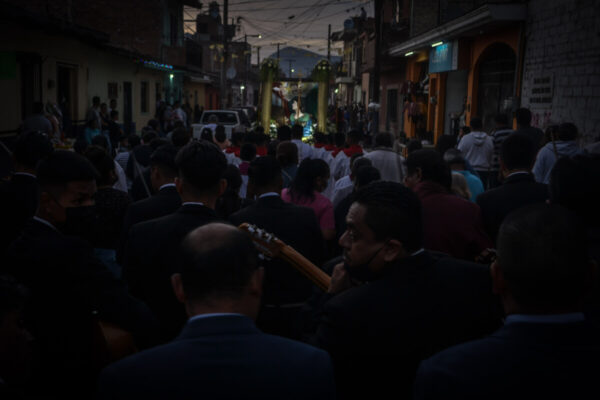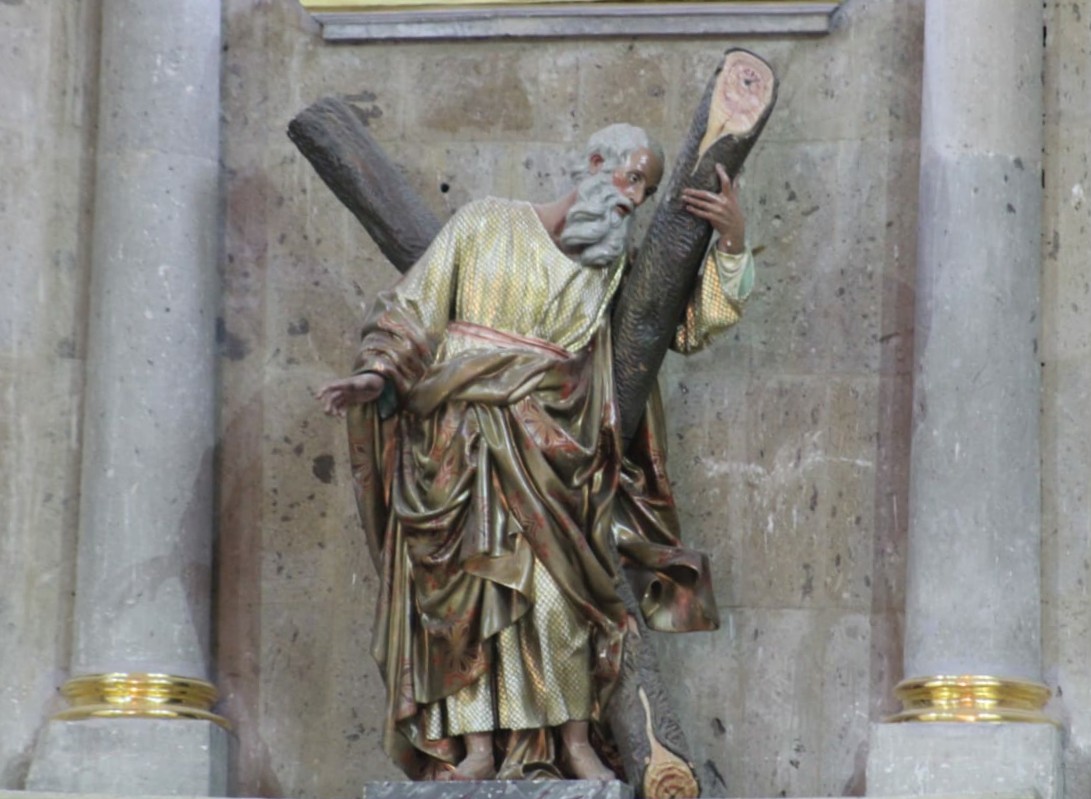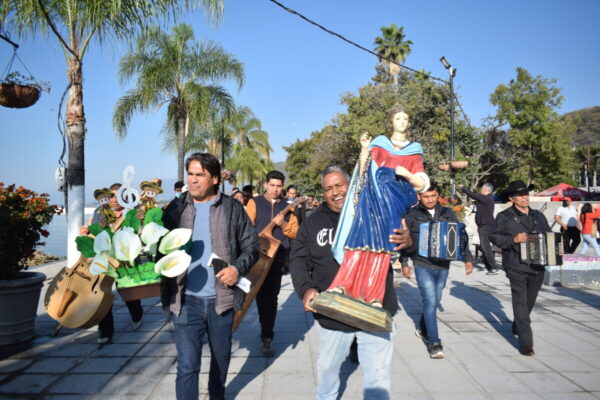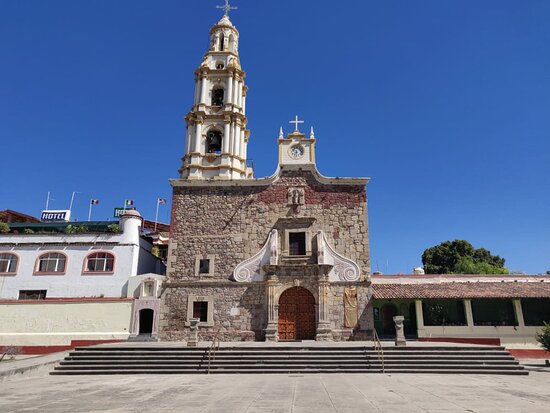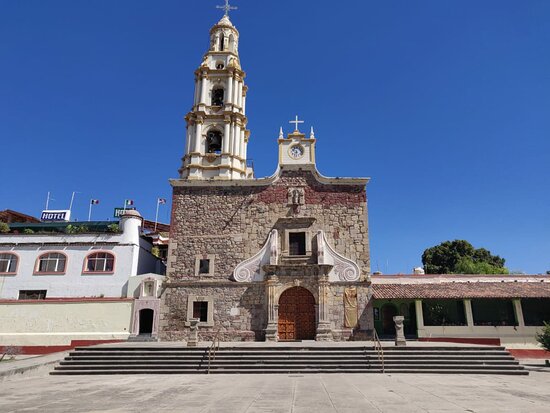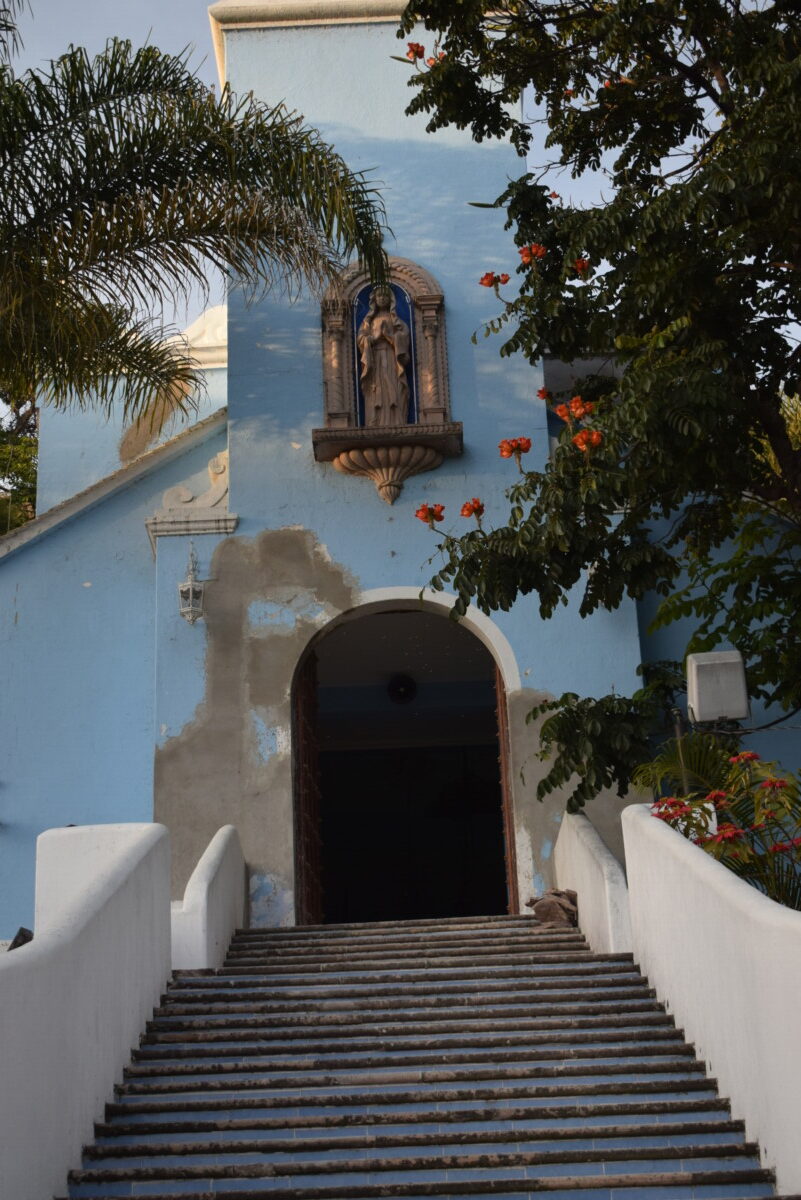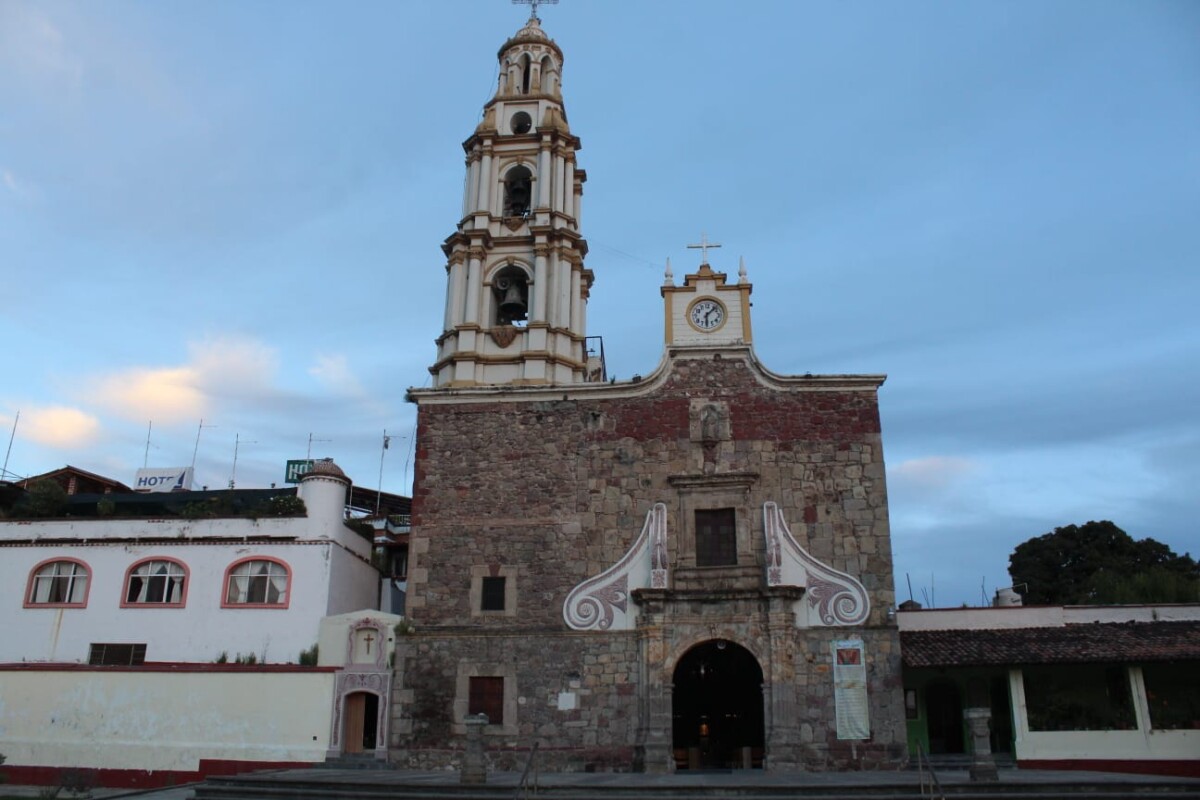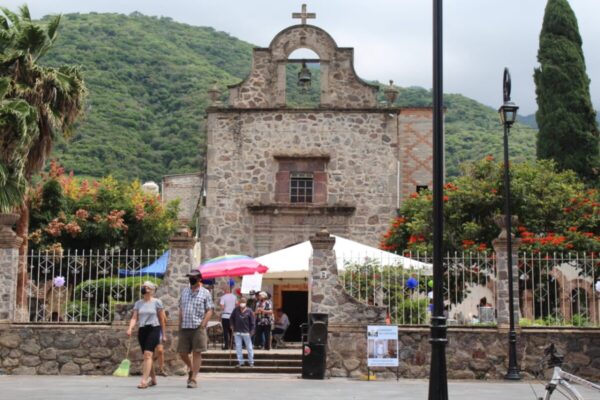religión
Con religiosidad y música celebran a Santa Cecilia en San Juan Cosalá
Durante la tarde noche del 22 de noviembre, tanto feligreses como músicos se reunieron para recorrer en procesión las calles de San Juan Cosalá. Foto: Héctor Ruíz.
D. Arturo Ortega. – La tradicional celebración a Santa Cecilia, patrona de los músicos en la delegación de San Juan Cosalá logró reunir tanto a feligreses como a músicos de la localidad quienes celebraron la fiesta de una manera religiosa a través de las calles de la población y su templo, así como con música en la plaza y convivio.
Te compartimos una serie de imágenes tomadas por Héctor Ruíz, en las que se refleja la manera de celebrar esta fiesta de los músicos, al estilo cosalense.
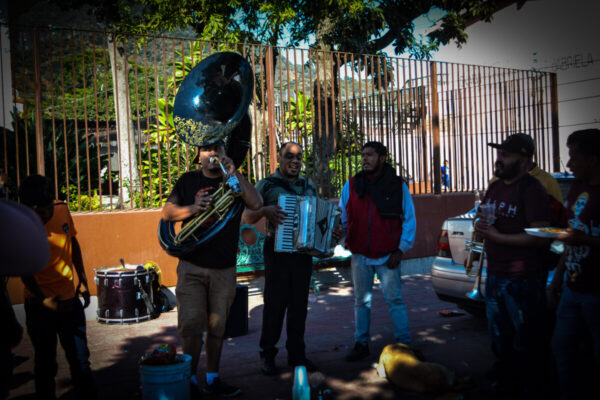
Durante la tarde los músicos se reunieron en la plaza para tocar algunas piezas musicales, donde también compartieron alimentos y bebidas.
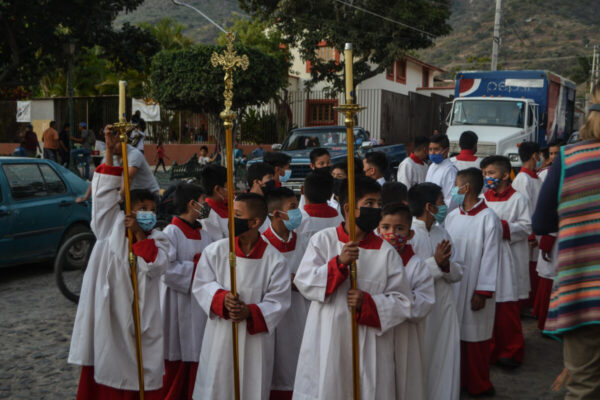
Previo al inicio de la procesión, los acólitos se preparan en formación con sus cirios y Cruz Alta.
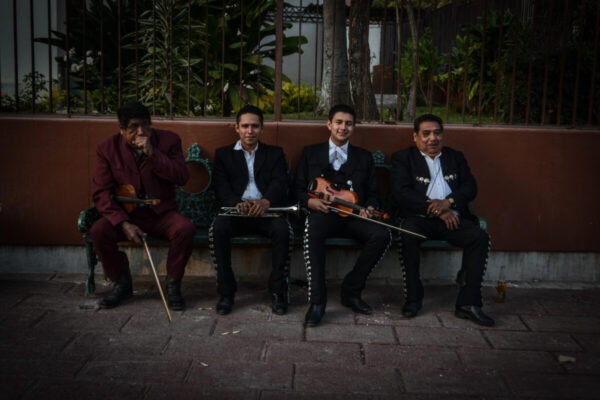
Cuatro mariacheros descansan en una banca en la plaza de la delegación de San Juan Cosalá, municipio de Jocotepec.
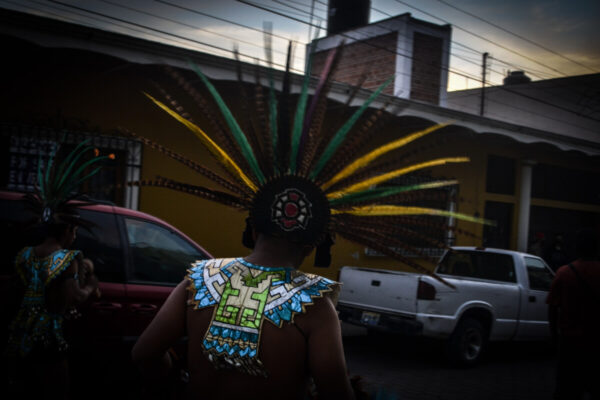
Los danzantes, como en cada procesión no pudieron faltar a la conmemoración de la patrona de los músicos, Santa Cecilia.
Green light for Ajijic to celebrate its Patron Saint with conditions
San Andrés Apostle, patron saint of Ajijic. Sofía Medeles.
Sofía Medeles / Translated by Patrick O’Heffernan (Ajijic, Jal.)– A few days before the start of Ajijic’s patron saint festivities (November 22-30), the authorities have finally given the green light for the festivities, which, due to pandemic restrictions, will be held as the ancestors used to do it, the old-fashioned way.
The conditions include a closing time of 12:00 midnight, a restricted capacity, sanitary checkpoints in charge of the guilds, signage at entrances and exits, permanent use of masks and monitoring by the Municipal Government.
Maximiliano «Max» Macias, who is in charge of the delegation’s office, commented that they are working together with merchants, guilds and organizing groups, to be able to bring a very healthy and old-fashioned celebration.
«They will be different this time the festivities, as to come with the family, spend some time and have dinner. We are starting little by little and reactivating the economy. For example, merchants who have not been able to make a living will be allowed to work, as long as they respect the requirements of the Ministry of Health,» said Max.
Likewise, through the delegation’s web page -Delegación Ajijic 2021-2024-, the calendar of activities for the novenario (9-days of masses and celebrations) was published; The guild schedule is: Nov.22nd musicians’ guild), Nov. 23rd merchants’ guild, Nov. 24th terrace owners who reached an agreement, and Nov. 25th the new youth guild). People agreed to bring musical groups to perform at the kiosk, while from November 26th to 30th, the activities that will take place will depend on the budget of the remaining guilds.
People have taken this news as good, since, both in social networks and in interviews conducted by Semanario Laguna, they expressed their joy for the realization of the festivities. «It is good because on the one hand we see that little by little we are getting out of this pandemic, and on the other hand because they give the population a space to have fun,» highlighted Sara, an interviewee from Ajijic.
Finally, the person in charge of the office called the attendees to the celebrations in honor of Saint Andrew the Apostle, and the merchants, to respect the established measures, otherwise, with all and penalty, they will be called to attention.
The program of the religious novena to St. Andrew the Apostle will be held as usual
The program of activities and participating guilds is on the wall of the parish of San Andrés Apóstol
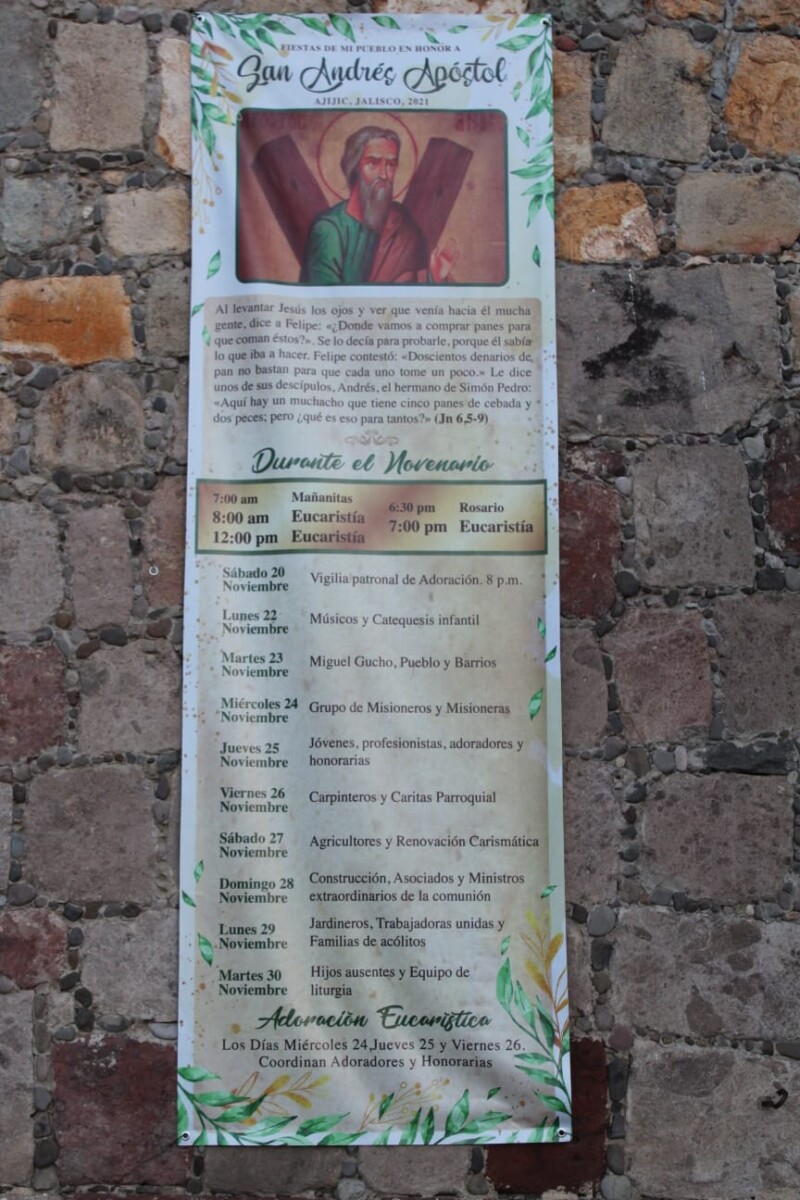
The program of activities and participating guilds is on the wall of the parish of San Andrés Apóstol.
Sofía Medeles /Translated by Elisabeth Shields (Ajijic, Jal.)- The religious celebration of San Andrés Apóstol will take place in the usual way -unlike the celebrations in the main square, which will have modifications-, with the mañanitas, masses, rosaries and Eucharistic adoration.
The mañanitas will be held at 7:00 a.m. The masses will be held at three different times, 8:00 a.m., 12:00 p.m. and 7:00 p.m. Rosaries will be at 6:30 p.m., and Eucharistic adoration – in charge of Adorers and Honorary Adorers – will be on Wednesday, November 24, Thursday, November 25 and Friday, November 26.
Tradición, fe y alegría dan vida al Día del Músico en Chapala
Luego de una misa celebrada en la Parroquia de San Francisco de Asís, los músicos llevan en un recorrido a la imagen de Santa Cecilia por el malecón de Chapala. Foto: Jazmín Stengel.
D. Arturo Ortega. – Con fe, tradición y música se vivió el 22 de noviembre, Día del Músico en Chapala, lugar donde desde muy temprano, por la mañana grupos de norteño, mariachis, tríos y solistas que laboran en los lugares más visitados de la cabecera municipal, se dieron cita en la Parroquia de San Francisco de Asís y el extremo oriente del malecón para celebrar a la patrona, Santa Cecilia.
A través de una serie de imágenes tomadas por Jazmín Stengel, te compartimos cómo la fe y la devoción se manifestó durante este día tan significativo para el gremio de la música:
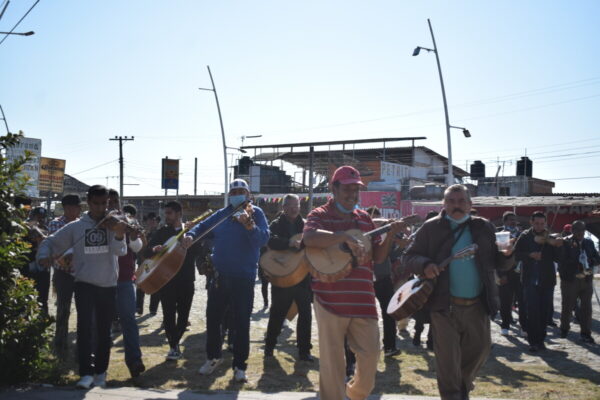
Una vez en la zona restaurantera, los músicos interpretaban canciones a petición de los lugareños de cada restaurante.
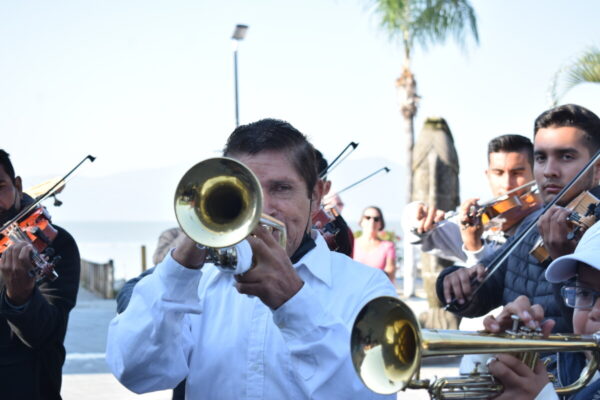
Los años de experiencia de algunos músicos son notables cuando interpretan las canciones de su repertorio.
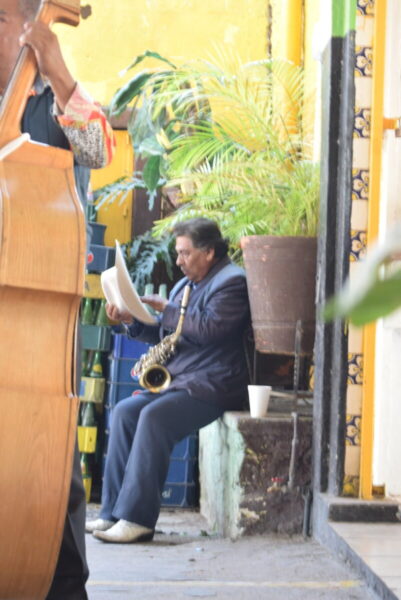
Luego de un considerable recorrido, un saxofonista de una agrupación de norteño, tomó un descanso para continuar su recorrido interpretando canciones para celebrar a Santa Cecilia.

Músicos de todas las edades acudieron a aportar un poco de su talento para conmemorar a Santa Cecilia.
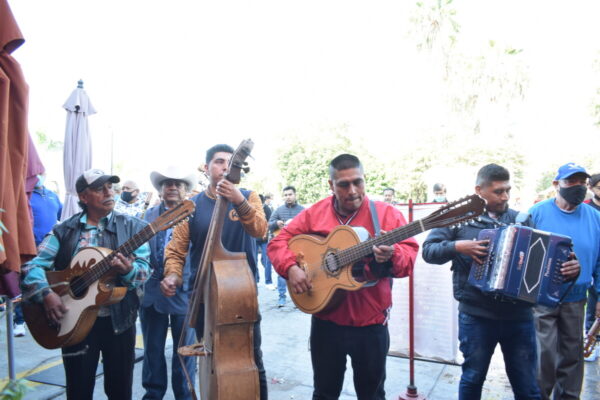
Las agrupaciones musicales que conviven en las zonas turísticas de Chapala no sólo son nativos del municipio, sino también de poblaciones circunvecinas.
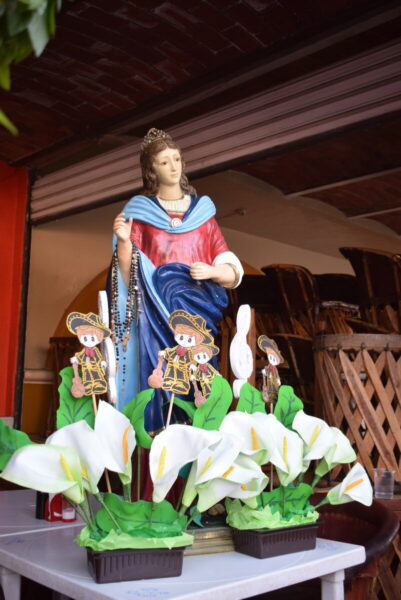
La imagen de Santa Cecilia recorrió cada restaurante antes de regresar a su capillita, ubicada en el extremo oriente del malecón de Chapala.
Ajijic’s agricultural guild in danger of disappearing
Photo: St. Andrew Catholic Church.
Sofía Medeles (Ajijic, Jal.)- With no fields to sow and no cows to herd in Ajijic, the farmers’ guild, once one of the strongest of the nine guilds, is now one of the hardest hit in the Ajijic’s patron saint festivities.
The festivities in honor of San Andrés Apóstol are held from November 22 to 30 In the Parish of San Andrés Apóstol, where the patron saint of Ajijic is located.
Semanario Laguna spoke with one of the members (of the guild. Ramona Díaz, receiving the media outside her house hiding her hands to protect herself from the cold, nostalgically commented that her membership in the guild is because she inherited it from her father, who inherited it from her grandfather. Senora Diaz acknowledged that the guild is one of those that has been fading the most with time.
«It used to be a robust day because there was a lot of farming and ranching, but the guild members have been doing less and less. Today there are fewer than 25 of us who cooperate, and there is no longer anywhere to plant or have livestock, that is why the festivities have been lost,» she mentioned while raising her voice a little to be able to stand out among the noise of trucks and cars passing by outside her home.
She went on to say that the only thing left is the name, because only memories of this trade remain, and they will probably be those of this last generation. «I don’t think I will pass it on to my children, because they are no longer committed to the faith or to the profession. Not only my children, many young people no longer approach religion today.»
She said that another important factor in the lack of participation not only in her guild, but in all the guilds,is the diminished the day of the youth which is a colorful day with a lot of celebration in other areas, but here it is different, because they have been leaving aside religion and customs, they only see the celebration.»
Looking to the side, she recalls a tradition that is basically lost, in which the guild on the following day, made a small procession with lanterns to get to the last mass of the day which represented that they were receiving their day. They called this the «entrada.» «It would be nice if those of us who participate in the guilds could agree to wear a shawl and wear our tresses, so we could show more of our traditions and roots.»
Finally, she called on the community of Ajijic, adults, youth and children, to get more involved in the traditions that remain since, with pride, she says it is part of what makes Ajijic magical. «Another one I remember is the battle of the roses -men giving roses to women during the dances in the plaza. It was nice and fun. It should be done again and we could motivate them, for example, by giving a prize to the one with the most roses. Let’s not let the traditions that made us what we are die.»
Translated by Sydney Metrick
Ajijic’s agricultural guild in danger of disappearing
St. Andrew Catholic Church.
Sofía Medeles (Ajijic, Jal.)- With no fields to sow and no cows to herd in Ajijic, the farmers’ guild, once one of the strongest of the nine guilds, is now one of the hardest hit in the Ajijic’s patron saint festivities.
The festivities in honor of San Andrés Apóstol are held from November 22 to 30 In the Parish of San Andrés Apóstol, where the patron saint of Ajijic is located.
Semanario Laguna spoke with one of the members (of the guild. Ramona Díaz, received the media outside her house hiding her hands to protect herself from the cold, nostalgically commented that her membership in the guild is because she inherited it from her father, who inherited it from her grandfather. Senora Diaz acknowledged that the guild is one of those that has been fading the most with time.
«It used to be a robust day because there was a lot of farming and ranching, but the guild members have been doing less and less. Today there are fewer than 25 of us who cooperate, and there is no longer anywhere to plant or have livestock, that is why the festivities have been lost,» she mentioned while raising her voice a little to be able to stand out among the noise of trucks and cars passing by outside her home.
She went on to say that the only thing left is the name, because only memories of this trade remain, and they will probably be those of this last generation. «I don’t think I will pass it on to my children, because they are no longer committed to the faith or to the profession. Not only my children, many young people no longer approach religion today.»
She said that another important factor in the lack of participation not only in her guild, but in all the guilds,is the diminished the day of the youth which is a colorful day with a lot of celebration in other areas, but here it is different, because they have been leaving aside religion and customs, they only see the celebration.»
Looking to the side, she recalls a tradition that is basically lost, in which the guild on the following day, made a small procession with lanterns to get to the last mass of the day which represented that they were receiving their day. They called this the «entrada.» «It would be nice if those of us who participate in the guilds could agree to wear a shawl and wear our tresses, so we could show more of our traditions and roots.»
Finally, she called on the community of Ajijic, adults, youth and children, to get more involved in the traditions that remain since, with pride, she says it is part of what makes Ajijic magical. «Another one I remember, is the battle of the roses -men giving roses to women during the dances in the plaza. It was nice and fun. It should be done again and we could motivate them, for example, by giving a prize to the one with the most roses. Let’s not let the traditions that made us what we are die.»
Translated by Sydney Metrick.
The Lourdes Chapel will open its doors to the public after three years of being closed
The neighbors of the Lourdes neighborhood will see the doors of their chapel open to the public for the celebration of the Virgin of Guadalupe. Photo Jazmín Stengel.
Jazmín Stengel – After being closed to the public for more than three years and after six months of restoration work, the Chapel of Lourdes will finally open its doors to the public to commemorate the day of the Virgin of Guadalupe on December 12, as was done in 1940.
To date, more than 500,000 pesos (almost $24,000 USD) have been invested in the restoration work, according to the civil engineer, Enrique Petersen. These resources come from what the neighbors have been able to raise through donations, most of the time in material.
«Unlike earlier, they now prefer anonymous donations», commented Alejandra Martinez, daughter of Tere and Jose (Pepe) Martinez, neighbors of the community and treasurers of this collection. She added that many Chapalenses and foreigners have contributed their share, including Enrique Petersen who undertook the job of directing the work without charging a peso.
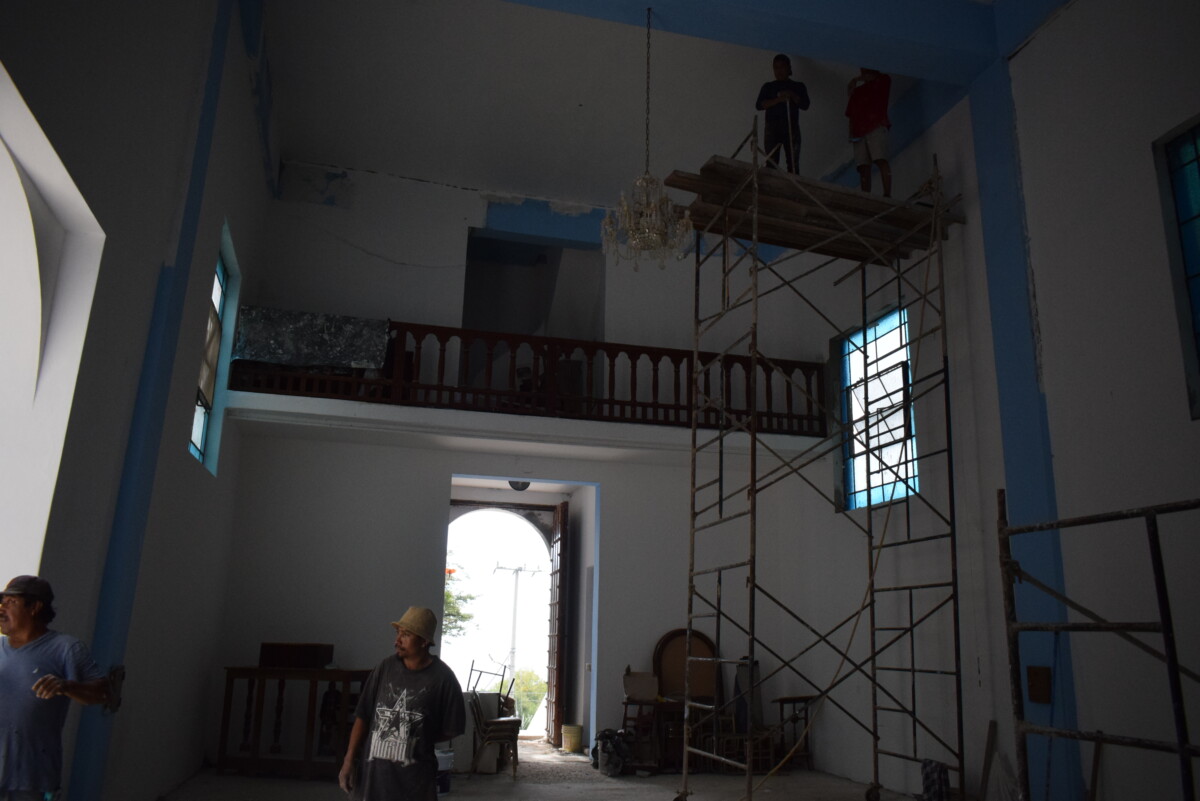
After six months of restoration work, there are still pending details of painting and finishing in the temple. Photo Jazmín Stengel.
The task has not been easy, since the labor expenses and some materials not donated tallied up to 70 thousand pesos one month, with even more expenses. The average monthly expenses remained at 20 thousand pesos, which has covered the payroll of four stonemasons.
The steady collection of resources has been maintained thanks to fairs, raffles, sales, and the monthly contributions of more than 200 pesos, which the neighbors of the neighborhood pledged to contribute.
Petersen said that when he began the plans for the restoration of the exterior, he discovered the poor condition of the foundation, and that part of the only tower was cracked.
«We started by fixing the base of the chapel and reinforcing its walls with metal and concrete, we removed the outside balcony that was pushing out one of the walls and repaired the cracks,» said the engineer, who added: «These details and water leaks from the hill impacted the infrastructure severely enough to close it in September 2019, almost 80 years after its inauguration,» he concluded.
At the end of the first stage of restoration, only cosmetic and finishing details such as painting, carpentry and gardening are pending, for which more budget is needed. However, the committee in charge, together with engineer Petersen, decided to reopen the chapel so that the community can see what has been achieved.
The chapel was built in 1940 by Guillermo González Hermosillo y Brizuela, who led the cooperation between the neighbors of Colonia Francesa and the Ixtle neighborhood to make possible the construction of the sanctuary.
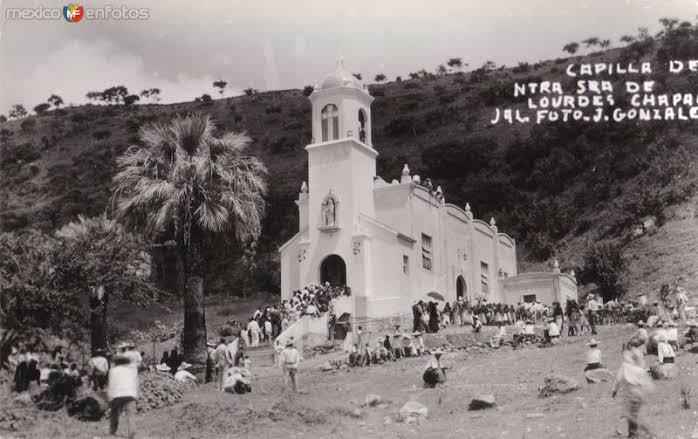
Photograph of the first years of the Lourdes Chapel. Photo: J. González.
Now it is the turn for the second generation of neighbors, the heirs of the luxurious country houses in Colonia Francesa and the inhabitants of the renowned neighborhood of Lourdes in Chapala, named in honor of their patron saint. These neighbors continue the restoration of the shrine week after week by selling churros, fritters, and sweets outside after mass, and others by making extravagant anonymous donations.
The fundraising work continues to help fund the remaining restoration work, and the next fair is already planned to be held on November 28 outside of the Parish of San Francisco de Asis. Another fair is planned for December 5 outside of the Chapel of Lourdes.
Translated by Kerry Watson.
The religious novena honoring St. Andrew the Apostle to be held in traditional manner
The banner listing the program of activities and participating guilds is on the façade of the church of St. Andrew the Apostle.
Sofía Medeles (Ajijic, Jal.)- The novena of nine days of religious celebrations to honor St. Andrew the Apostle will be carried out at the church in the customary way -unlike the celebrations in the main plaza, which will be modified- with the traditional mañanitas, masses, rosaries, and adoration of the Holy Eucharist.
The mañanitas will be held at 7:00 a.m.; while mass will be held at three different times, 8:00 a.m., 12:00 p.m. and 7:00 p.m. Rosaries will be at 6:30 p.m., and adoration of the Holy Eucharist- in the hands of adorers and honorary adorers – will be on Wednesday, November 24, Thursday, November 25 and Friday, November 26.
Translated by Kerry Watson.
Ajijic to celebrate its Patron Saint
Parish of San Andrés Apóstol, where the patron saint of Ajijic is located. The festivities in honor of San Andrés Apóstol take place from November 22 to 30. Photo: Sofía Medeles
Sofía Medeles (Ajijic, Jal.)– A few days before the start of the festivities in honor of the patron saint of Ajijic (November 22-30), the Chapala government has finally given the festivities a green light with conditions that guarantee they will be held as our ancestors used to do. That is to say, the old-fashioned way.
The municipal authorities conditioned its permission on a midnight shutdown time, a restricted capacity, sanitary filters run by the guilds, signage identifying entrances and exits, use of masks throughout the nine days of parties, and monitoring by the municipal government.
Maximiliano «Max» Macías, currently in charge of the Delegation office, commented that the delegation is working together with merchants, guilds and organizing groups to create a very healthy and old-fashioned celebration in the kiosk of the Plaza with small, local music groups. In the afternoon there will be cultural performances.
«The experience at the festivities will be different this time; people can come with the family, spend some time and have dinner. We are starting little by little and reactivating the economy. For example, merchants who have not been able to make a living, will be allowed to work, as long as they respect the requirements of the Ministry of Health,” said Max.
The calendar of activities for the novenario (nine days of parties) was published the delegation’s web page (Delegación Ajijic 2021-2024), which lists the guilds who have duty each day: on November 22nd, the musicians’ guild; on the 23rd, the merchants’ guild; on the 24th, terrace owners who reached an agreement; and on the 25th , the new youth guild. These have all agreed to bring musical groups (who will perform at the kiosk). From November 26th to 30th the activities to be carried out will depend on the budget of the remaining guilds.
Residents see this as good news and have expressed their enthusiastic approval in social networks and interviews conducted by Semanario Laguna.
«It is good because on the one hand we see how little by little we are getting out of this pandemic, and on the other hand because they give the population a space to have fun,» said Sara from Ajijic to Laguna.
Maximiliano «Max» Macías called upon those attending the celebrations in honor of Saint Andrew the Apostle, and the merchants at the festivities, to respect the conditions and the Covid measures, noting that violators may be penalized.
Translated by Dee Lynn
Sí habrá celebración de Fiestas Patronales en Chapala
Templo de San Andrés Apóstol. Foto: Archivo.
D. Arturo Ortega. – Luego de la falta de respuesta por parte de la Mesa de Salud Jalisco para conceder la realización de reuniones para realización de celebraciones, el Ayuntamiento de Chapala anunció que sí se llevarán a cabo las fiestas patronales a realizarse en próximas fechas, pero con ciertas restricciones.
“El límite de horario será las 12:00 de la noche, aforo restringido a un máximo de personas (no especificado) y la instalación de filtros sanitarios, con responsabilidad para los gremios y grupos que organizan las festividades”, serán parte de las restricciones y responsabilidades.
Lo anterior se realizó por parte de las Autoridades Municipales, en atención a las diversas peticiones de los habitantes, grupos organizados y gremios, ha determinado que se conceden permisos para llevar a cabo eventos.
Entre las fiestas más esperadas en el municipio se encuentran las fiestas de San Andrés Apóstol, Santo Patrono del Pueblo Mágico de Ajijic que se celebrarán a través de un novenario que concluye el 30 de noviembre.
Chapel restoration project is close to starting
The Chapel of Our Lady of the Rosary, in Ajijic, is close to starting the restoration project
Sofía Medeles (Ajijic, Jal.)- The project for the restoration of Ajijic’s Chapel of Our Lady of the Rosary is very close to starting, and after four fundraising events, the group “Sumando Voluntades” or Summoning Volunteers is ready to take the next step.
Their most recent event was the seventh annual Run for the Rosary, held on the day of the Virgin of the Rosary, October 31, with 180 runners participating in the race. The race and the fair held on the same day raised 40 thousand pesos, giving a total of approximately 350 thousand pesos that the group has raised to start working.
The architect in charge of the project, Josué Ramos, said that the restoration project was presented to the National Institute of Anthropology and History (INAH) and needs some modifications, however, the capital raised is enough to get started.
«They asked us to revise the structural project to the specifications provided by the architect of the INAH. The architect said that we don’t have to spend all the capital in the first stage since they were quite simple things to start with,» Josué asserted.
He also added that they have more events in mind, although they have yet to plan the details or set the date. In the short term, they plan to focus on the architectural survey and the necessary restructuring.
«We will continue to raise funds for this project. For the moment, we are thinking of selling a black and white poster with the Virgin of the Rosary and the little chapel in the background, which we will start selling during the patron saint festivities and whenever we have the opportunity», concluded the architect Josué.
Translated by Kerry Watson.
© 2016. Todos los derechos reservados. Semanario de la Ribera de Chapala
